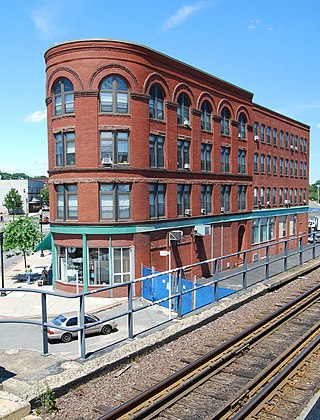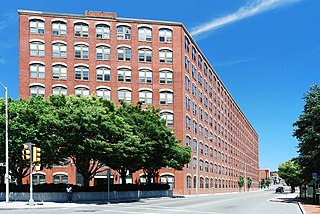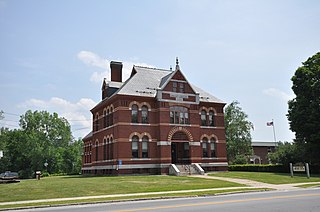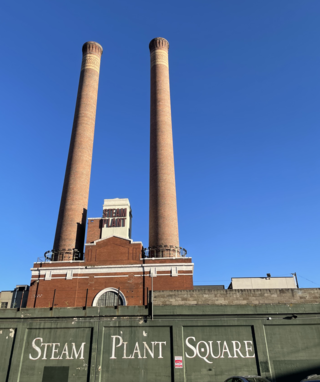
The First Universalist Church is a historic church building on the corner of Pleasant, Elm, and Spring Streets in Auburn, Maine. It was built in 1876 to a design by John Stevens of Boston, Massachusetts, and has been a significant landmark in the city since its construction. It is a fine local example of Gothic Revival architecture executed in brick, and was listed on the National Register of Historic Places in 1979.

The B B Chemical Company is an historic office and industrial building at 784 Memorial Drive in Cambridge, Massachusetts. It was built in 1937 for the Boston Blacking Company, an adhesive manufacturer whose most famous brand name was Bostik, to a design by Coolidge, Shepley, Bulfinch & Abbott, and is a prominent local example of Streamline Moderne architecture. From 1979 to 1996, it served as the headquarters of the Polaroid Corporation. The building was added to the National Register of Historic Places in 1982 under the incorrect name "B and B Chemical Company". It is now owned by The Bulfinch Companies of Needham, Massachusetts.

The Old Weir Stove Company was an historic industrial facility located on West Water Street in Weir Village, Taunton, Massachusetts. The factory consisted of a series of connected brick buildings, located between West Water Street and the west bank of the Taunton River. The factory was built in 1902 and added to the National Register of Historic Places in 1984. It was later occupied by F.B. Rogers Silver Company. In May–June 2009, the site was demolished, except for the northernmost building of the complex.

The Morgan Block is a historic commercial block at 313-333 Bridge Street in Springfield, Massachusetts. When the two story Classical Revival building was built in 1929, it was probably a speculative real estate venture by the Morgan Envelope Company, whose factory abutted the property in the rear. It was designed to house stores on the first floor and offices on the second, functions it continues to perform. It was rehabilitated in the early 1980s and listed on the National Register of Historic Places in 1983.

The Olmsted-Hixon-Albion Block is a historic commercial block at 1645-1659 Main Street in the north end of downtown Springfield, Massachusetts. The building is actually three separate 19th-century buildings that were conjoined by internal connections in 1929, making a good example of adaptive reuse of commercial architecture in the city. The building was listed on the National Register of Historic Places in 1983.

The Springfield Steam Power Company Block is a historic industrial building at 51-59 Taylor Street in downtown Springfield, Massachusetts. Built in 1881, it is a surviving example of a late 19th-century power distribution component, part of a scheme by the Springfield Steam Power Company to deliver steam power to nearby industrial facilities. The block was listed on the National Register of Historic Places in 1983. Its ground floor now houses "The City Church", a local community of Jesus followers.

The Capitol Diner is a historic diner at 431 Union Street in Lynn, Massachusetts. Built in 1928 by the J. G. Brill Company, it is believed to be that company's last operating diner. It was listed on the National Register of Historic Places in 1999.

The Fabens Building is a historic commercial building at 312-344 Union Street in Lynn, Massachusetts. The four story brick building was built in 1890, replacing two buildings that were destroyed in Lynn's disastrous 1889 fire. It was built for William Fabens, a Marblehead lawyer and judge who maintained offices in the city and sat on the city police court. The building had seven storefronts on the ground floor, with office space on the upper floors. Designed by local architect Henry Warren Rogers, it is one Lynn's most significant Romanesque Revival buildings.

The Munroe Street Historic District encompasses some of the few commercial buildings to survive in downtown Lynn, Massachusetts from the mid 19th century. The district includes properties on Munroe Street between Market and Washington Streets, which was spared by the 1889 fire that destroyed much of Lynn's downtown area. It was listed on the National Register of Historic Places in 1996.

The Intervale Factory is a historic Late-Victorian factory building at 402 River Street in Haverhill, Massachusetts. Built in 1889, it is one of Haverhill's better-preserved shoe factory buildings. Now converted to apartments, it was listed on the National Register of Historic Places in 1988.

The Vamp Building is a historic factory building at 3-15 Liberty Square in downtown Lynn, Massachusetts. The eight-story brick building was built in 1903 as the Lynn Realty Company Building #4 to a design by local architect Henry Warren Rogers, and was extended over the next four years to occupy the entire city block bounded by Washington Street, Union Street, and Liberty Square. The "flatiron" V-shape of the building was the basis for its name, as it resembles the shape of the vamp of a shoe. The building served in its early years as a home for all manner of businesses related to the manufacture of shoes. At the time of its construction it was the largest brick building of its kind in the world.

The Item Building is a historic commercial building at 26 Albion Street in Wakefield, Massachusetts. Built in 1912, the single-story brick building serves as the headquarters of The Wakefield Daily Item, Wakefield's main community newspaper, and is a well-kept example of early 20th century commercial architecture.

The H. M. Warren School is a historic school building at 30 Converse Street in Wakefield, Massachusetts. Built c. 1895–1897, it is locally significant as a fine example of Renaissance Revival architecture, and for its role in the town's educational system. The building was listed on the National Register of Historic Places in 1989. It now houses social service agencies.
The Boston Edison Power Station is a historic power station at 374 Homer Street in Newton, Massachusetts. Built in 1904 and twice enlarged, it is a significant reminder of the city's early electrification efforts, providing power to both area buildings and the local streetcar network. The building was listed on the National Register of Historic Places in 1990. It presently serves as a power distribution hub.

The Longyear Building is a commercial structure located at 210 North Front Street in Marquette, Michigan. It was listed on the National Register of Historic Places in 2004.

The Conant Public Library is the public library of Winchester, New Hampshire. It is located at 111 Main Street, in a fine Victorian Romanesque Revival building erected in 1891, funded by a bequest from Winchester resident Ezra Conant. The building's design, by Springfield, Massachusetts architect, J. M. Currier, is based on his design of the 1886 library building in Brattleboro, Vermont, and is one of the most architecturally distinguished buildings in Cheshire County. It was listed on the National Register of Historic Places in 1987.

The Kimball Brothers Shoe Factory is a historic factory building at 335 Cypress Street in Manchester, New Hampshire. The four-story brick building was built in stages between 1885 and 1900, and was a prototypical structure from which the design of other period shoe factories in Manchester were built. Construction was overseen by Head & Dowst, a builder responsible for a number of area public buildings, including schools and prisons. It was funded by local businessmen seeking to diversify the local economy, and was leased to the Kimball Brothers, a leading shoe manufacturer in Lynn, Massachusetts. The building was listed on the National Register of Historic Places in 1985.

The Franklin Block is a historic commercial building at 75 Congress Street in downtown Portsmouth, New Hampshire. Built in 1879, this three-story brick building is the largest Victorian-era building standing in the city. It occupies the city block between Fleet Street and Vaughan Mall, a former street that is now a pedestrian mall. It was listed on the National Register of Historic Places in 1984.

The Central Steam Heat Plant, commonly known as Steam Plant Square, or simply as the Steam Plant, is a historic building in Downtown Spokane, Washington. Originally built to provide steam heating to more than 300 buildings in Spokane's city center, the Steam Plant served that purpose until the 1980s, when it was no longer viable. In the 1990s, the Steam Plant and adjacent Seehorn-Lang Building were converted into Steam Plant Square, a commercial, retail and restaurant center. The conversion maintained many of the industrial steam plant structures such as furnaces, boilers, catwalks and pipe networks, which can still be seen and explored by visitors and patrons. The Steam Plant's pair of 225-foot-tall stacks have been a unique and iconic aspect of the city's skyline for more than a century, and are illuminated from their base at night. If the stacks were considered to be a building, they would rank as the third tallest in the city.
The Lynn Item Building is a historic commercial building at 38-54 Exchange Street in downtown Lynn, Massachusetts. It was built in 1900-1901 to a design by local architect Henry Warren Rogers. It was home to The Daily Item, the city's leading newspaper, until 2014, and is the city's only surviving 19th-century purpose-built newspaper building. It was listed on the National Register of Historic Places in 2023. It was converted to mixed commercial and residential use in 2021.





















